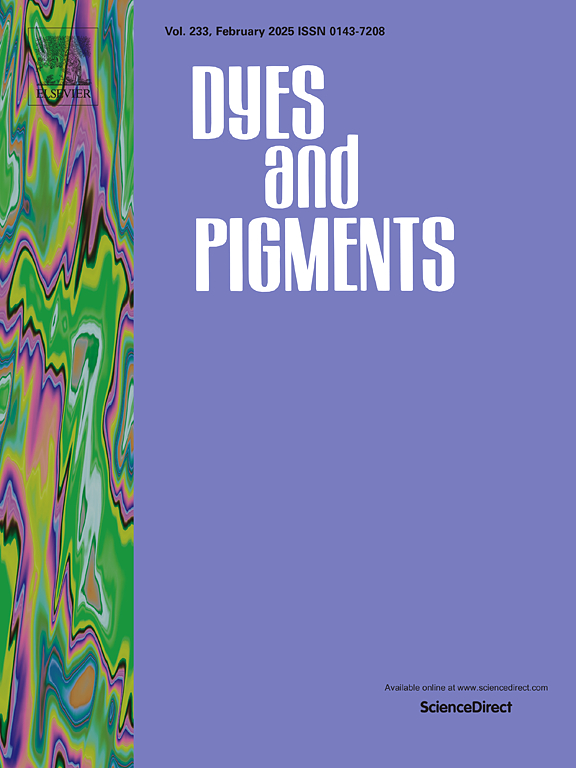Design, synthesis and characterization of triphenylamine-based conjugated porous polymers as fluorescent receptors for nitroaromatic derivatives
IF 4.2
3区 工程技术
Q2 CHEMISTRY, APPLIED
引用次数: 0
Abstract
Two series of hyperbranched conjugated polymers were synthesized via straightforward oxidative coupling polymerization, starting from star-shaped triphenylamine compounds with different internal π-spacers, each varying through the electron-withdrawing properties and rigidity. Excellent total reaction yields were achieved, exceeding 80 % under emulsion reaction conditions, particularly when employing compounds with high electron-withdrawing character (-CN). The polymers containing p-phenylene-vinylene and mixed p-phenylene (vinylene)-ethynylene structures were obtained predominantly as insoluble powders, mainly due to their fully aromatic backbone structure or highly cross-linked formed networks, and their chemical structures were validated by FT-IR analysis. Optical studies revealed that polymers synthesized under classical reaction conditions exhibited enhanced π-conjugation compared to those obtained via emulsion oxidative conditions, which was clearly reflected in a red-shift of the absorption and emission maxima. Conversely, the use of surfactants along with planar and rigid triple bonds facilitated the formation of more porous polymer networks, with the highest specific surface areas of 492 m2g-1, compared to analogous networks based on vinylene hyperbranched polymers (99 m2g-1) and (cyano)vinylene hyperbranched polymers (44 m2g-1). The fluorescence emission of these polymers as solid dispersions in chloroform, although of low intensity for the CN-containing polymers, enables them to detect the nitro-aromatic derivatives via fluorescence quenching. The dependence of both detection limit and emission quenching efficiency on the polymers backbone structure and employed synthesis method was obvious. Notably, the Stern-Volmer quenching constant (KSV) was highest for TNP, reaching 17.9 × 103 M-1 in the case of p-phenylene-vinylene polymer synthesized under emulsion reaction conditions, indicating promising avenues for the development of solid-state fluorescence sensors.

作为硝基芳香族衍生物荧光受体的三苯胺基共轭多孔聚合物的设计、合成和表征
我们通过直接氧化偶联聚合反应合成了两个系列的超支化共轭聚合物,这些聚合物以具有不同内部π-间隔的星形三苯胺化合物为起点,每种化合物的吸电子特性和刚性各不相同。在乳液反应条件下,特别是在使用具有高吸电子特性(-CN)的化合物时,反应总产率超过 80%。含有对亚苯基-乙烯和混合对亚苯基(乙烯)-乙炔结构的聚合物主要以不溶性粉末的形式获得,这主要是由于它们具有全芳香族骨架结构或高度交联形成的网络。光学研究表明,与通过乳液氧化条件合成的聚合物相比,在传统反应条件下合成的聚合物表现出更强的π-共轭作用,这明显反映在吸收和发射最大值的红移上。相反,与基于乙烯超支化聚合物(99 m2g-1)和(氰基)乙烯超支化聚合物(44 m2g-1)的类似网络相比,使用表面活性剂以及平面和刚性三键有助于形成更多孔的聚合物网络,最高比表面积为 492 m2g-1。虽然含 CN 的聚合物在氯仿中的固体分散体的荧光发射强度较低,但它们能够通过荧光淬灭来检测硝基芳香族衍生物。检测限和发射淬灭效率对聚合物骨架结构和合成方法的依赖性显而易见。值得注意的是,在乳液反应条件下合成的对苯乙烯-乙烯聚合物中,TNP 的斯特恩-沃尔默淬灭常数(KSV)最高,达到 17.9 × 103 M-1,这表明固态荧光传感器的开发前景广阔。
本文章由计算机程序翻译,如有差异,请以英文原文为准。
求助全文
约1分钟内获得全文
求助全文
来源期刊

Dyes and Pigments
工程技术-材料科学:纺织
CiteScore
8.20
自引率
13.30%
发文量
933
审稿时长
33 days
期刊介绍:
Dyes and Pigments covers the scientific and technical aspects of the chemistry and physics of dyes, pigments and their intermediates. Emphasis is placed on the properties of the colouring matters themselves rather than on their applications or the system in which they may be applied.
Thus the journal accepts research and review papers on the synthesis of dyes, pigments and intermediates, their physical or chemical properties, e.g. spectroscopic, surface, solution or solid state characteristics, the physical aspects of their preparation, e.g. precipitation, nucleation and growth, crystal formation, liquid crystalline characteristics, their photochemical, ecological or biological properties and the relationship between colour and chemical constitution. However, papers are considered which deal with the more fundamental aspects of colourant application and of the interactions of colourants with substrates or media.
The journal will interest a wide variety of workers in a range of disciplines whose work involves dyes, pigments and their intermediates, and provides a platform for investigators with common interests but diverse fields of activity such as cosmetics, reprographics, dye and pigment synthesis, medical research, polymers, etc.
 求助内容:
求助内容: 应助结果提醒方式:
应助结果提醒方式:


